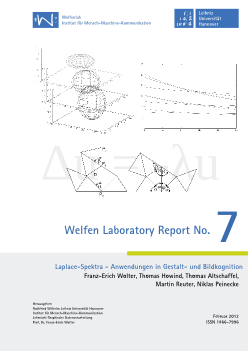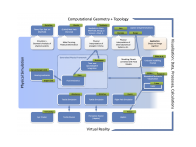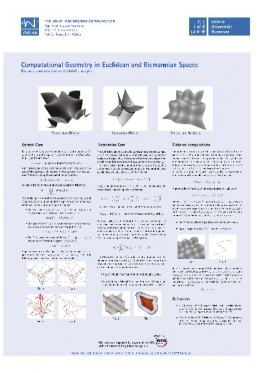Publikationen
Welfenlab Reports
Durch unsere Veröffentlichungsreihe Welfen Laboratory Reports informieren wir über Forschungsarbeiten an unserem Lehrstuhl, unter anderem werden auf diesem Weg ausgewählte studentische Abschlussarbeiten publiziert.
Publikationen nach Jahren
Hier finden sie sämtliche Publikationen des Welfenlab geordnet nach Art der Publikation und Erscheinungsdatum.
Sie finden hier auch ein vollständige Publikationsliste.
| 1979 . . . 2009 | 2010 | 2011 | 2012 | 2013 | 2014 | 2015 | 2016 |
2014
| Artikel |
| 2014 |
Asan Agibetov, Ricardo Manuel Millán Vaquero, Karl-Ingo Friese, Giuseppe Patanè, Michela Spagnuolo and Franz-Erich Wolter Integrated Visualization and Analysis of a Multi-scale Biomedical Knowledge Space Proceedings of the EuroVis Workshop on Visual Analytics 25-29 The Eurographics Association 2014 Beschreibungstext anzeigen The study and analysis of relationships in a complex and multi-scale data set is a challenge of information and scientific visualization. This work proposes an integrated visualization to capture all the important aspects of multi-scale data into the same view by leveraging the multi-scale biomedical knowledge encoded into an underly- ing ontology. Ontology supports visualization by providing semantic means to identify relevant items that must be presented to the user. The study and analysis of relationships across the scales are presented as results of queries to the multi-scale biomedical knowledge space. We demonstrate the prototype of the graphical interface of an integrated visualization framework and the knowledge formalization support in an example scenario related to the musculoskeletal diseases. |
Jan Rzepecki, Ricardo Manuel Millan Vaquero, Alexander Vais, Karl-Ingo Friese, Franz-Erich Wolter Multimodal Approach for Natural Biomedical Multi-scale Exploration Lecture Notes in Computer Science 8888 620–631 Springer Switzerland 2014 Beschreibungstext anzeigen Pathologies which simultaneously involve different spatial scales are often difficult to understand. Biomedical data from different modalities and spatio-temporal scales needs to be combined to obtain an understandable representation for its examination. Despite of requests to improve the exploration of multi-scale biomedical data, no major progress has been made in terms of a common strategy combining the state of art in visualization and interaction. This work presents a multimodal approach for a natural biomedical multi-scale exploration. The synergy of a multi-layered visualization environment based on spatial scales with hand gestures and haptic interfaces opens new perspectives for a natural data manipulation. |
Franz-Erich Wolter Shape and Image Cognition, Construction and Compression via Tools from Differential Geometry (lecture at MIT) 2014 Beschreibungstext anzeigen Lecture given at Massachusetts Institute of Technology (september 11, 2014) by Prof. F.-E. Wolter. More information:
This work starts with basic medial axis results presented by the the author in the early nineties. Those results state: The Medial Axis Transform can be used to reconstruct, modify and design a given shape ("Shape Reconstruction Theorem"). Under some weak assumptions the medial axis contains the essence of the topological shape of the geometric object as it is a deformation retract of the given shape ("Topological Shape Theorem"). Therefore the medial axis contains the homotopy type of the given shape. We present recent results showing how geodesic Voronoi diagrams, geodesic medial axis and its inverse can be computed in 3d- or higher-dimensional Riemannian spaces. The "medial axis inverse" allows to construct a medial modeler providing efficient features for shape optimization with respect to shape dependent mechanical properties. |
| Beiträge in Büchern |
| 2014 |
R. M. Millán Vaquero, J. Rzepecki, K.-I. Friese, F.-E. Wolter Visualization and User Interaction Methods for Multiscale Biomedical Data 5 N. Magnenat-Thalmann, O. Ratib, and H. F. Choi Springer London 2014 Beschreibungstext anzeigen The need for handling huge amounts of data from several sources is becoming increasingly important for biomedical scientists. In the past, there were mainly different modalities in imaging techniques that had to be combined. Those modalities usually measured different physical effects from the same object and shared dimensions and resolution. Nowadays, an increasing number of complex use cases exist in biomedical science and clinical diagnostics that require data from various domains, each one related to a different spatiotemporal scale. Multiscale spatial visualization and interaction can help physicians and scientists to explore and understand this data. In the recent years, the number of published articles on efficient scientist-centric visualization and interaction methods has drastically increased. This chapter describes current techniques on multiscale visualization and user interaction and proposes strategies to accommodate current needs in biomedical data analysis. |






